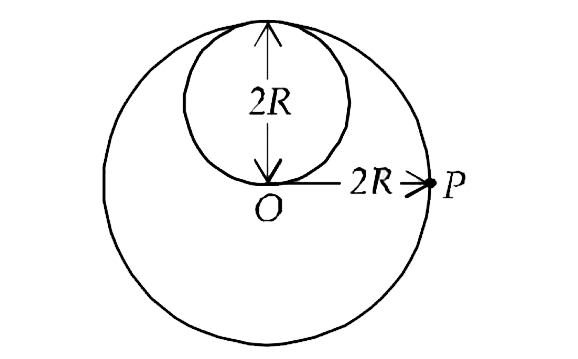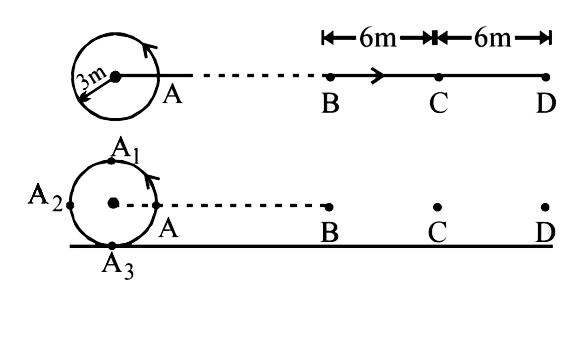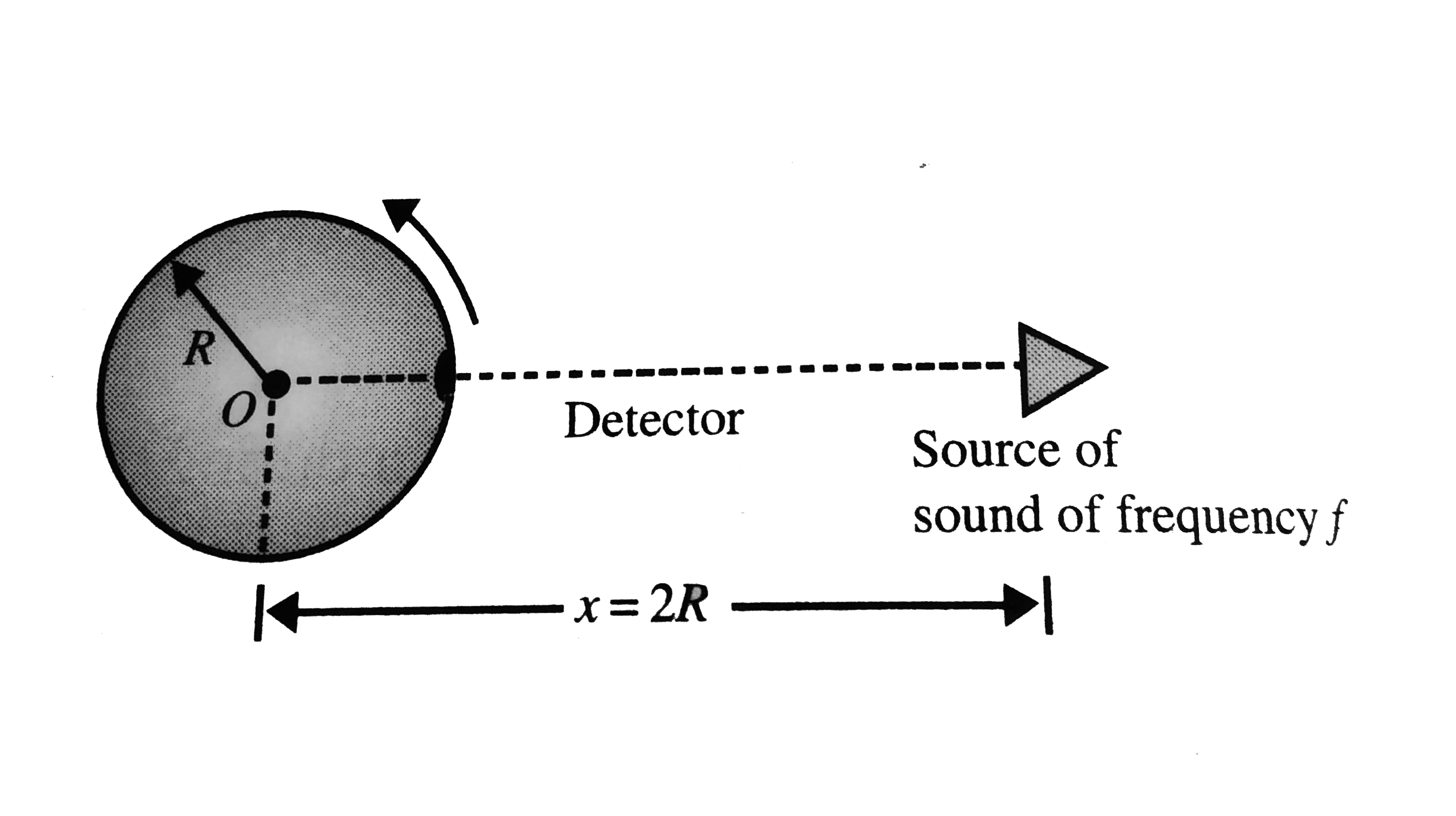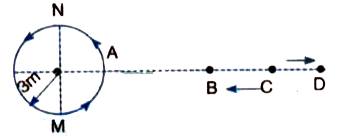A source of sound is moving along a circular orbit of radius 3 m with an angular velocity of 10 rad/s. A sound detector located far away from the source is executing linear S.H.M. along the line BD (see Fig. 14.4.13) with an amplitude BC = CD=6m. The frequency of oscillation of the detector is 5/π per second. The source is at the point BA when the detector is at the point B. If the source epiits a continuous sound wave of frequency 340 Hz, find the maximum and the minimum frequencies recorded by the detector. 
Speed of source,
vS=rω=3×10=30ms
Maximum speed of detector,
vmax=vd=Aω'=A2πf'=6×2π×5π=60ms
The speed of sound is v=330ms
The frequency recorded by detector is maximum when source and detector approach each other (i.e., source at F and detector at C after times 3T4, and 3T4, respectively, T and T' being time periods of source and detector). Then maximum frequency is given by
nmax=v+vdv−vSn
=330+60330−30×340=390300×340=442Hz
The frequency recorded by detector is minimum when source and detector recede from each other (i.e., source at E and detector at C after time T4) , so that the minimum frequency is
nmin=v−vdv+vSn
=330−60330+30×340=270360×340=255Hz
Topper's Solved these Questions
- SOUND WAVES AND DOPPLER EFFECTBook:CENGAGE PHYSICS ENGLISHChapter:SOUND WAVES AND DOPPLER EFFECTExercise:Exercise 6.1
Explore 56 Videos
- SOUND WAVES AND DOPPLER EFFECTBook:CENGAGE PHYSICS ENGLISHChapter:SOUND WAVES AND DOPPLER EFFECTExercise:Exercise 6.2
Explore 72 Videos
- SOUND WAVES AND DOPPLER EFFECTBook:CENGAGE PHYSICS ENGLISHChapter:SOUND WAVES AND DOPPLER EFFECTExercise:Integer
Explore 16 Videos
- RIGID BODY DYNAMICS 2Book:CENGAGE PHYSICS ENGLISHChapter:RIGID BODY DYNAMICS 2Exercise:Interger
Explore 2 Videos
- SUPERPOSITION AND STANDING WAVESBook:CENGAGE PHYSICS ENGLISHChapter:SUPERPOSITION AND STANDING WAVESExercise:Comprehension Type
Explore 5 Videos
Similar Questions
Do displacement particle velocity and pressure variation in a longitudinal wave vary with the same phase?
View SolutionA person riding on a merry go round emits a sound wave of a certain frequency Does a person at the centre observe the Doppler effect?
View SolutionThe average power transmitted across a cross section by two sound waves moving in the same direction are equal. The wavelength of two sound waves are in the ratio of 1:2, then find the ratio of their pressure amplitudes.
View SolutionA lamina is made by removing a small disc of diameter 2R from a bigger disc of uniform mass density and radius 2R, as shown in the figure. The moment of inertia of this lamina about axes passing though O and P is IOandIP respectively. Both these axes are perpendicular to the plane of the lamina. The ratio IPIO is

View SolutionA string of length L, fixed at its both ends is vibrating in its 1st overtone mode. Consider two elements of the string of the same small length at positions l1=0.2Landl2=0.45L from one end.
If K1andK2 are their respective maximum kinetic energies,then
View SolutionA small source of sound oscillates in simple harmonic motion with an amplitude of 17 cm. A detector is placed along the line of motion of the source. The source emits a sound of frequency 800 Hz which travels at a speed of 340ms−1 If the width of the frequency band detected by the detector is 8 Hz, find the time period of the source.
View SolutionA source of sound is moving along a circular orbit of radius 3meter with an angular velocity of 10rad/s. A sound detector located far away from the source is executing linear simple harmonic motion along the line BD with an amplitude BC=CD=6meters. the frequency of oscillation of the detector is 5π per second. the source is at the point A when the detector is at the point B. if the source emits a continous sound wave of frequency 340Hz, find the maximum and the mnimum frequencies recorded by the detector.

View SolutionA source of sound and detector are arranged as shown in Fig. The detector is moving along a circle with constant angular speed omega . It start from the shown location in anticlockwise direction at t=0 (Take velocity of sound in air as v) What is the frequency as received by detector, when it rotates by an angle (pi)/(2) ?
View Solution
A source of sound and detector are arranged as shown in Fig. The detector is moving along a circle with constant angular speed ω. It start from the shown location in anticlockwise direction at t=0
(Take velocity of sound in air as v)
Q. Find the time at which the detector will hear the maximum frequency for the first time.
View SolutionA source of sound and detector are arranged as shown in Fig. The detector is moving along a circle with constant angular speed omega . It start from the shown location in anticlockwise direction at t=0 (Take velocity of sound in air as v) Find the time interval between minimum and maximum frequency as received by the detector.
View Solutionएक बुलेट ट्रैन 396 km/h की चाल से सीधी पटरी पर 1200 Hz की आवृति की ध्वनि उतपन्न करती हुई चल रही है । एक ध्वनि संसूचक स्रोत की गति रेखा से 1000 m की दूरी पर स्थित है । (a) जिस समय स्रोत संसूचक से न्यूनतम दूरी पर है, उस समय संसूचक द्वारा प्राप्त ध्वनि की आवृति निकाले । (b) जिस समय संसूचक 1200 Hz की आवृति की ध्वनि प्राप्त करता है, उस समय स्रोत एवं संसूचक के बीच की दूरी निकाले । हवा में ध्वनि की चाल 340 m/s ले ।
View Solutionएक ध्वनि - स्रोत 3 मी त्रिज्या की वृत्तीय कक्षा में 10 रेडियन से के कोणीय वेग से घूम रहा है। स्रोत से काफी दूर स्थित एक ध्वनि संसूचक BD रेखा के अनुदिश रेखीय सरल आवर्त गति कर रहा है जिसका आयाम BC = CD = 6 मी है।
संसूचक के दोलन की आवृत्ति 5/π प्रति सेकण्ड है। जब संसूचक बिन्दु B पर है , तब स्रोत बिन्दु A पर है। यदि स्रोत 340 हर्ट्ज आवृत्ति की अविरत ध्वनि तरंग उत्सर्जित करता है तो संसूचक द्वारा अभिलेखित उच्चतम व न्यूनतम आवृत्तियाँ ज्ञात कीजिए (ध्वनि की चाल = 340 मी / से)

View SolutionA source of soud is moving along a circular orhit of dins 3 m with an angular velocity of 10 rad/s. sound detector located far away from the source is executing linear simple harmonic motion along the line BD with amplitude BC = CD = 6m. The frequency oscillation of the detector is (5//pi) rev/sec. The source is at the point A when the detector is at the point B. If the source emits a continuous sound wave of frequency 340 H, find the maximum and the minimum frequencies recorded by the detector velocity of sound :: 330 m/s)
View SolutionA source of sound emitting a frequency 660 Hz is moving counter-clockwise in a circular path of radius 2 metres with an angular velocity 15 rad/s. A recorder at a distance from the source is moving simple harmonically along a straight line with an amplitude 2 metres. The frequency of SHM is 15/(2pi) per second. The arrangement is shown in figure. When the source is at point A the detector is at D. Find the maxium and minimum frequencies recorded. Velocity of sound in air at this temperature can be taken as 300 m/s
View SolutionA source of sound is moving along a circular orbit of radius 3m with an angular velocity of 10 red/s. A sound detector located far away from the source is executing linear simple harmonic motion along the line BD with amplitude BC = CD = 6m. The frequency of oscillation of the deterctor is (5/π) rev/sec. The source is at the point A when the detector is at the point B. If the source emits a continuous sound wave of frequency 340 Hz, find the maximum and the minimum frequencies recorded by the detector [velocity of sound =330 m/s].

View SolutionA source of sound is moving along a circular orbit of radius 3 m with an angular velocity of 10 rad/s. A sound detector located far away from the source is executing linear S.H.M. along the line BD (see Fig. 14.4.13) with an amplitude BC = CD=6m. The frequency of oscillation of the detector is 5//pi per second. The source is at the point BA when the detector is at the point B. If the source epiits a continuous sound wave of frequency 340 Hz, find the maximum and the minimum frequencies recorded by the detector.
View Solution
